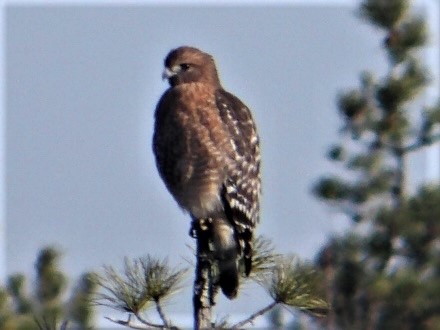I have always said that November & February are my least favorite months--cold, dreary, gray. I still feel that way about February, but what with climate change, November doesn't seem so bad anymore. Rarely this month did I have to wear a heavy coat and I went gloveless most of the time. But climate change means that the ducks don't have to move south and that, coupled with the mysterious dearth of land birds, has meant that finding a place with a lot of species has been a chore. I went to all my regular spots this month and some less frequently visited spots and then some places I only hit once or twice a year. Nowhere, with the exception of Brig, had much of interest. Whitesbog, where we yearn in the summer for the bogs to be drawn down, has not been able to attract the usual Tundra Swan flock because, ironically, the bogs remain drawn down, with only Union Pond back to its winter level.
I would have to say that the bird that gave me the biggest boot this month was one in our backyard. One afternoon, when I glanced up at the feeders, I saw a fairly big bird with a yellow breast and wing bars and no, it wasn't the much prayed-for Evening Grosbeak. It flew away fairly quickly. I thought maybe it was a weird House Finch--I think I remember reading that sometimes they can have an orange cast instead of red. I told Shari and she said, "Sounds like a Baltimore Oriole."
 |
| Baltimore Oriole at our feeder |
For the month I had 119 species, which, checking eBird, is slightly down from the previous two years. Three year birds--the Barred Owl early in the month and the two birds at Brig recently recounted. I made a trip up to Assunpink on Sunday to see the Trumpeter Swans that have returned for the 10th year running. Talk about site loyalty!
Counties birded: Atlantic, Burlington, Monmouth, Ocean
Snow Goose Double Trouble SP
Brant Hideaway Cove
Canada Goose Colliers Mills WMA
Mute Swan Island Beach SP
Trumpeter Swan Assunpink WMA
Tundra Swan Whitesbog
Wood Duck Whitesbog
Northern Shoveler Manasquan Reservoir IBA
Gadwall Holly Lake
American Wigeon Holly Lake
Mallard Golden Drive
American Black Duck Cattus Island County Park
Northern Pintail Brig
Green-winged Teal Whitesbog
Redhead Island Beach SP
Ring-necked Duck Whitesbog
Greater Scaup Brig
Lesser Scaup Brick Township Reservior
Surf Scoter Island Beach SP
White-winged Scoter Island Beach SP
Black Scoter Island Beach SP
Long-tailed Duck Island Beach SP
Bufflehead Cattus Island County Park
Common Goldeneye Brig
Hooded Merganser Lake Barnegat
Red-breasted Merganser Island Beach SP
Ruddy Duck Cattus Island County Park
Pied-billed Grebe Reeves Bogs
Rock Pigeon New Egypt
Mourning Dove 35 Sunset Rd
American Coot Manasquan Reservoir IBA
American Oystercatcher Great Bay Blvd
Black-bellied Plover Island Beach SP
Killdeer Whitesbog
Sanderling Island Beach SP
Dunlin Brig
Purple Sandpiper Island Beach SP
Least Sandpiper Brig
Long-billed Dowitcher Brig
Wilson's Snipe Cranberry Bogs
Greater Yellowlegs Whitesbog
Lesser Yellowlegs Whitesbog
Bonaparte's Gull Island Beach SP
Laughing Gull Cattus Island County Park
Ring-billed Gull Manasquan Reservoir IBA
Herring Gull 35 Sunset Rd
Lesser Black-backed Gull Island Beach SP
Great Black-backed Gull Island Beach SP
Royal Tern Island Beach SP
Red-throated Loon Island Beach SP
Common Loon Island Beach SP
Northern Gannet Island Beach SP
Double-crested Cormorant Tilton Point
American White Pelican Brig
Brown Pelican Island Beach SP
Great Blue Heron Whitesbog
Great Egret Island Beach SP
Snowy Egret Waretown
Black Vulture 35 Sunset Rd
Turkey Vulture Whitesbog
Northern Harrier Island Beach SP
Sharp-shinned Hawk Island Beach SP
Cooper's Hawk Colliers Mills WMA
Bald Eagle 35 Sunset Rd
Red-shouldered Hawk Whitesbog
Red-tailed Hawk New Egypt
Barred Owl Jumping Brook Preserve
Belted Kingfisher Whitesbog
Yellow-bellied Sapsucker Jumping Brook Preserve
Red-bellied Woodpecker Whitesbog
Downy Woodpecker Whitesbog
Hairy Woodpecker Whitesbog
Northern Flicker Whitesbog
American Kestrel Pointville Rd
Peregrine Falcon Island Beach SP
Eastern Phoebe Jumping Brook Preserve
Blue Jay 35 Sunset Rd
American Crow 35 Sunset Rd
Fish Crow Waretown
Common Raven Whitesbog
Carolina Chickadee 35 Sunset Rd
Tufted Titmouse 35 Sunset Rd
Ruby-crowned Kinglet Whitesbog
Golden-crowned Kinglet Whitesbog
Red-breasted Nuthatch 35 Sunset Rd
White-breasted Nuthatch 35 Sunset Rd
Brown Creeper Whitesbog
Winter Wren Whitesbog
Carolina Wren 35 Sunset Rd
European Starling Colliers Mills WMA
Gray Catbird Cattus Island County Park
Northern Mockingbird Colliers Mills WMA
Eastern Bluebird Colliers Mills WMA
Hermit Thrush Whitesbog
American Robin Whitesbog
House Sparrow Tilton Point
House Finch 35 Sunset Rd
American Goldfinch 35 Sunset Rd
Snow Bunting Island Beach SP
Chipping Sparrow Double Trouble SP
Field Sparrow Jumping Brook Preserve
Fox Sparrow 35 Sunset Rd
Dark-eyed Junco 35 Sunset Rd
White-throated Sparrow 35 Sunset Rd
Saltmarsh Sparrow Brig
Savannah Sparrow Colliers Mills WMA
Song Sparrow Whitesbog
Swamp Sparrow Whitesbog
Eastern Towhee Whitesbog
Eastern Meadowlark Colliers Mills WMA
Baltimore Oriole 35 Sunset Rd
Red-winged Blackbird Tilton Point
Rusty Blackbird Jumping Brook Preserve
Common Grackle Golden Drive
Boat-tailed Grackle Great Bay Blvd
Common Yellowthroat Whitesbog
Yellow-rumped Warbler Whitesbog
Black-throated Gray Warbler Brig
Northern Cardinal 35 Sunset Rd












